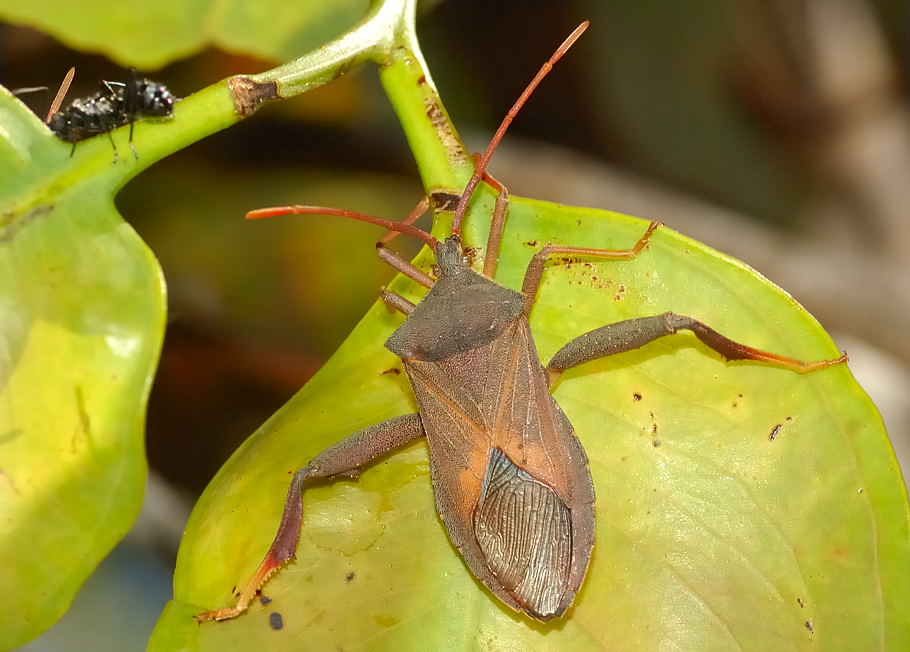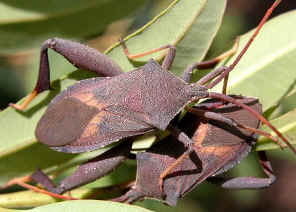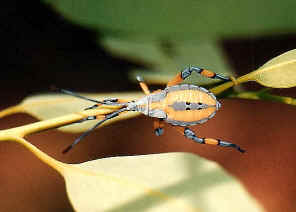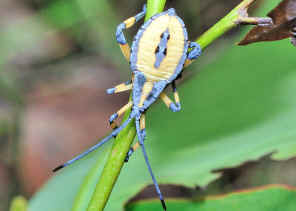Eucalyptus Tip-wilter Bug, Clown Bug - Amorbus robustus
Family Coreidae
This page contains pictures and information about Eucalyptus Tip-wilter Bugs that we found in the Brisbane area, Queensland, Australia. They are also known as Clown Bugs.

- Female, body length 22mm
- There are many common names for the Clown Bugs. They are also known as Coreid Bugs, Common Gum Tree Bugs, Sap Sucking Bugs or Squash Bugs. The adults are reddish brown in colour, with strong and spiny hind legs. There are parallel veins on their forewings, with orange yellow on the wing covers and a sharp angle on each shoulder. Their antennae are four segmented. Their abdomen are long and thin with greenish-yellow to brown colour on the bottom, bright orange black banded on the top, covered by wing-covers. They are slow moving. When disturbed, they move to other side of the leaf. The bug may eject smelly liquid as defence.
- This is the most common Amorbus species in Brisbane. As all other bugs in this genus, they feed on shoots of Eucalyptus trees. Males have shouter hind femora and spiny hind legs. Their nymphs are variable mixed bright colours.
- Males have shouter hind femora and spiny hind legs.



- Male



- Female


- Mating pair Male and female
- The above picture shows the mating couple, from them we can tell their male and female are looked very similar and about the same size. The picture shows one bug with its wings broken. Reason is unknown, anyways, we can see the bright orange colour and black strips on the top of its abdomen.

- Eggs of Amorbus sp.
- After mating, female lay eggs on host plants. Eggs are laid singly on the leaf surface of young leaves, several eggs are laid close together. Most coreid eggs look very similar. Above photo was taken on Dec 2004 in Karawatha Forest.
Male and Female
Eggs
Five Instars Stages
- Their life cycle is one generation per year. In early summer, we easily found many of them feeding on the young leaves and new shoots on different Gum trees. After hatching from eggs, Clown Bugs have five immature stages. Different stages instars are found on the same Gum tree in early summer. They are in vary colours and patterns.
-

- 1st instars, body length 8mm, as far as we found, all 1st instars are same colour patterns.
- Nymphs can be found feeding in clusters on young shoots. After hatching from eggs, the 1st instars all stay at the new shot of the gum tree and start feeding. They have powerful sucking mouthparts, or stylets, which they insert into the plant to suck the sap.



- 2nd instars, body length 10mm
- We noticed that on the gum tree there are some wilted young shoots. Otherwise the trees are healthy and seems not affected very much by those bugs.
-



- 3rd instars, body length 15mm
- Notice how the wing buds developed in different instars stage.
-



- 4th instars, body length 18mm
-

- The above picture show a pale blue nymph become black/yellow after moulting.



- 5th or last instars, body length 20mm
- There are the dark blue colour forms as well.
-

- They are known to produce smelly defensive liquids when disturbed. We never have this experience from them. Every time when we approach them, we do it very gently. They seem not so aggressive as those stink bugs that we found, such as the Bronze Orange Bugs, which ejected the smelly liquid to us even we are half a meter away.
-



- Scent-gland outlet
- In the above first pictures, the small hole between its hind leg and middle leg, is the scent-gland outlet, from which the bug ejects the smelly liquid. The other holes on its abdomen are the spiracles where air enter the insect body for respiration. Nymph scent-gland outlets are on the top side of the abdomen.


- The above first picture shows an adult with defected wings. The reason of the defect is unknown. We can see the abdomen colour pattern, which is dark bands on orange colour, a warning pattern shown when wings are opened.
The Smelly Bug
Why the Clown Bugs have the strong hind legs?
- Some species in Family Coreidae, including this Clown Bugs, have their hind legs expanded and somewhat leaf-like. Some of them are commonly called Leaf Footed Bugs. The bugs cannot jump like grasshoppers. They do not use their legs to catch other insects like preying mantids. Their legs seems not effective as a defence weapon. Why the bugs have their strong hind legs?
-



- We sometimes found the male and female bugs standing on the top of a small plant with one hind leg extended. In one the above pictures, one of the the bug's hind leg is missing. It did not change it posture even we disturbed.



- From our observations, we believe the bugs' strong hind legs is the result of sexual selection. The females choose their mates with stronger hind legs. The males fright with each other with their hind legs.



- We have put two male Clown Bugs together, sometimes they fright with each other. They hold each other with the front and middle legs, use their hind legs try to cut the others hind legs. If we inspect carefully, we can see that the front part of their hind leg is like a saw and the middle parts of the hind leg form a cutter. We do see a bugs broken his hind legs after frighting. And the fright was end soon after one loss his hind leg.
- We can predict that a male bug will have the stronger hind legs. By checking with a number of mating pair, we found that this is true. And we learn how to tell the gender of a Clown Bugs by looking at its hind legs.
- This explain why sometimes we can see a Clown Bugs setting on the plant tip with its hind legs fully extend outwards. This is a male advertising his hind legs are so strong, or at least have not been broken. The strong and well shaped hind legs are used as the sign of fitness by the female bugs.
- This also explain for some species, their hind legs are over emphasised as board leaf-like.
- This should predict a female will only mate with a male with two good hind legs. We have observed many mating pairs but cannot have conclusion yet. We do sometimes find mating pair with single-hind-leg male. We need more observations on this.
- Reference:
- 1. Insects
of Australia, CSIRO, Division of Entomology, Melbourne University
Press, 2nd Edition 1991, pp 504.
- 2. Specimen Image Index - Insect Reference Collection Database - ICDB, Western Australian Department of Agriculture, 2006.
- 3. Insects of Australia and New Zealand - R. J. Tillyard, Angus & Robertson, Ltd, Sydney, 1926, p147.
- 4. Species Amorbus robustus Mayr, 1865 - Australian Faunal Directory, Australian Biological Resources Study.
- 5. Studies on the biology, immature stages, and relative growth of some Australian bugs of the superfamily Coreoidea (Hemiptera: Heteroptera) - Kumar, R. 1966, Australian Journal of Zoology 14: 895-991 [908].
[ Up ] [ Eucalyptus Tip-wilter Bug I ] [ Eucalyptus Tip-wilter Bug II ] [ Eucalyptus Tip-wilter Bug III ] [ Eucalyptus Tip-wilter Bug IV ] [ Eucalyptus Tip-wilter Bug V ] - 2. Specimen Image Index - Insect Reference Collection Database - ICDB, Western Australian Department of Agriculture, 2006.
